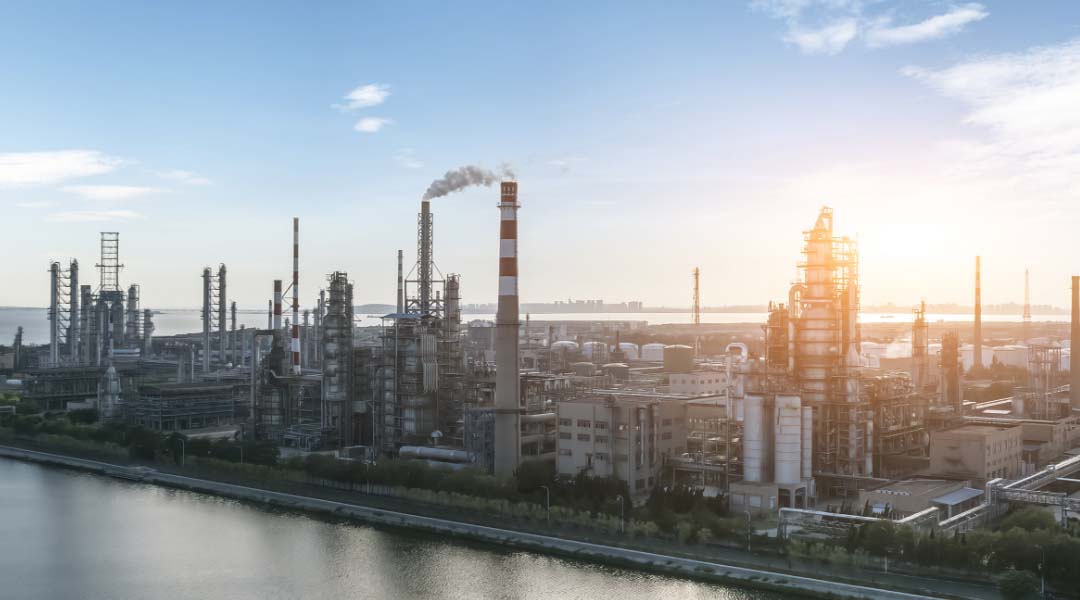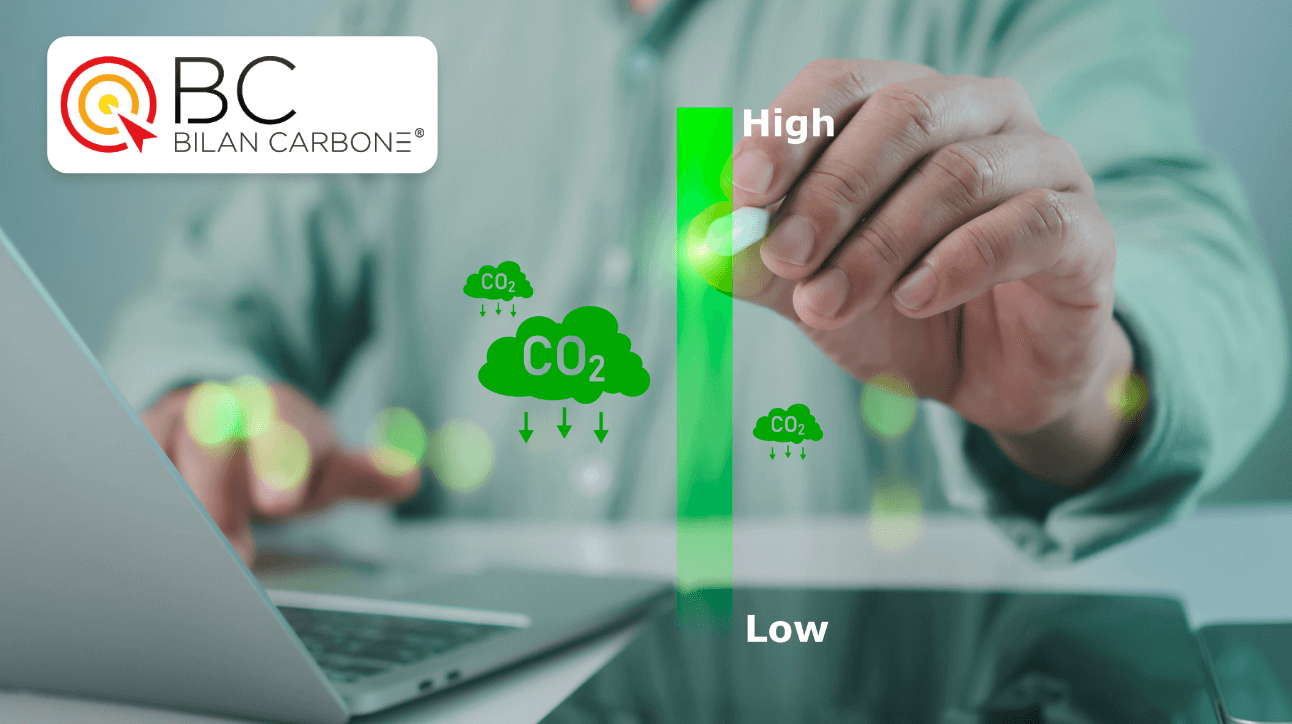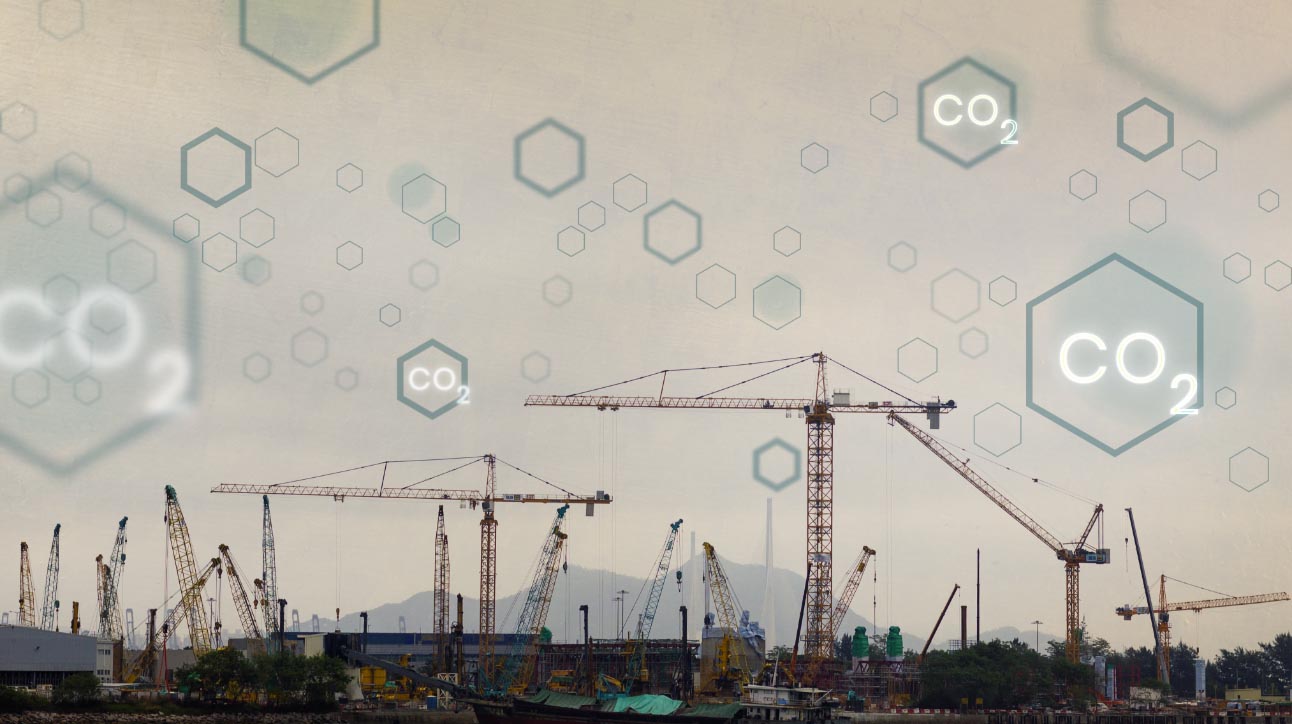When discussing greenhouse gases, carbon dioxide (CO₂) and methane (CH₄) often take centre stage. These two compounds have higher emissions, and their presence can be directly linked to human activities such as burning fossil fuels and agricultural practices.
But what is the most potent greenhouse gas? Various researches are currently tackling this, yet one stands to be the most potent and concerning in the long run: sulphur hexafluoride (SF₆).
Though not as well-known as CO₂ or CH₄ because it is released in much smaller quantities, SF₆’s unique properties make it just as, or even more, harmful. With a global warming potential (GWP) tens of thousands of times greater than CO₂ and an atmospheric lifetime that spans thousands of years, SF₆ is the most potent greenhouse gas ever identified.
This guide explores the significance of SF₆, why it is a major concern despite its relatively low emissions, and how industries and policymakers can address its environmental impact.
What is SF₆ Gas?
Sulphur hexafluoride (SF₆) is a synthetic, colourless, odourless, and non-flammable gas composed of one sulphur atom and six fluorine atoms. It was first synthesised in the early 20th century and quickly gained popularity for its unique properties:
- High Stability: SF₆ gas is chemically inert, meaning it does not react to other substances under normal conditions. This stability contributes to its long atmospheric lifetime.
- Exceptional Dielectric Properties: SF₆ has a high dielectric strength, making it an excellent electrical insulator. It can withstand high voltages without breaking down, making it ideal for use in electrical systems.
- Non-Toxicity: SF₆ is non-toxic and does not pose direct health risks to humans in low concentrations, which makes it safe to handle under controlled conditions.
To understand the role of SF₆ in the context of climate change, it’s important to consider Global Warming Potential (GWP), which measures how much heat a greenhouse gas traps in the atmosphere over a specified period (usually 100 years) compared to CO₂. CO₂ is used as the baseline with a GWP of one (1). While it has a long atmospheric lifetime, lasting centuries, its heat-trapping effect is relatively gradual.
Methane (CH₄), though less abundant than CO₂, has a GWP of 25, meaning it traps 25 times more heat than CO₂ over 100 years. However, methane has a shorter atmospheric lifetime, around 12 years.
SF₆, in comparison, has a very high GWP of 23,500, meaning it is 23,500 times more effective at trapping heat than CO₂ over 100 years. Despite being used in smaller quantities than CO₂ or CH₄, SF₆ has a long atmospheric lifetime, up to 3,200 years, which means that even small amounts can have a significant long-term impact on the environment. SF₆ is primarily used in electrical equipment and other specialised applications.
What is SF₆ gas used for?
SF₆ is used in several industries where its unique properties are highly valued, including:
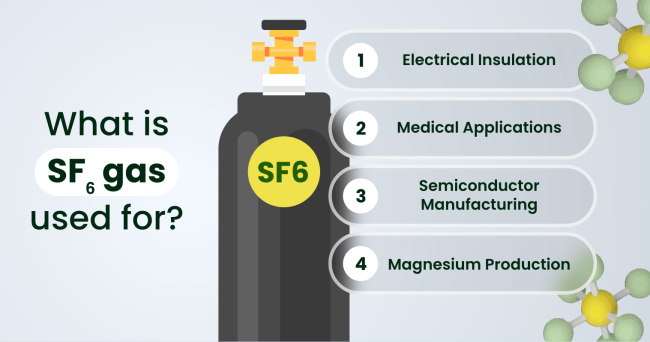
1. Electrical Insulation
The most common use of SF₆ is in the electrical power industry, where it serves as an insulating and arc-quenching gas in high-voltage equipment, such as gas-insulated switchgear (GIS), circuit breakers, and transformers.
SF₆’s ability to prevent electrical discharges and withstand high voltages makes it indispensable for maintaining power grid stability and safety. Gas-insulated systems that use SF₆ are compact, reliable, and efficient, which is why they are widely used in modern electrical infrastructure.
2. Medical Applications
In the medical field, SF₆ is used as a tamponade gas during eye surgeries, particularly in the treatment of retinal detachments. It helps create pressure within the eye, allowing the retina to reattach and heal properly. SF₆ is also used in some diagnostic imaging applications like ultrasounds and lung function tests due to its inert and stable nature.
3. Semiconductor Manufacturing
In the electronics industry, SF₆ is used as a plasma etching gas in semiconductor manufacturing. It helps create precise patterns on silicon wafers, which are essential for producing microchips and other electronic components.
4. Magnesium Production
SF₆ is used as a protective blanket in magnesium casting to prevent the metal from reacting with oxygen. Magnesium is highly reactive at high temperatures, and SF₆ creates an inert barrier that prevents oxidation during the casting process.
Why are SF6 emissions an environmental concern?
While it is highly effective for its intended use, the same unique properties of SF6 greenhouse gas make it extremely consequential to the environment.
As mentioned earlier, SF6 has an extraordinarily high Global Warming Potential (GWP). This means that it is vastly more effective at trapping heat. It also doesn’t help that SF6 is also incredibly stable, with an atmospheric lifespan of approximately 3,200 years. Once released, it remains in the atmosphere for millennia, continuously contributing to global warming.
Beyond its environmental implications, SF₆ gas’s effects on human health require attention, particularly in occupational settings. Under normal conditions, SF₆ is non-toxic and inert, meaning it does not react to human tissue or pose a direct chemical hazard. This property makes it suitable for use in closed systems where it remains stable. However, its physical characteristics can introduce risks in certain scenarios.
SF₆ is roughly five times denser than air, making it capable of displacing oxygen in confined or poorly ventilated spaces. If significant concentrations accumulate, it can create an asphyxiation hazard, particularly for workers in enclosed environments. Proper ventilation is crucial to prevent such incidents, as oxygen displacement can occur rapidly and without warning.
Additionally, SF₆ can decompose into harmful byproducts when exposed to high temperatures or electrical discharges. These byproducts, including sulphur dioxide (SO₂) and hydrogen fluoride (HF), are toxic and can irritate the skin, eyes, and respiratory system. Prolonged or high-level exposure to these substances can have more serious health implications.
Why has SF6 greenhouse gas not been phased out yet?
Over the last few years, there have been a few attempts to ban the use of SF6. In 2014, the European Union set a target to ban SF6 by 2030. Likewise, in the early 2000s, the US enacted monitoring, tracking, and reporting guidelines for SF6 emissions in the electrical industry.
Despite its environmental drawbacks, SF₆ gas continues to be used due to its technical superiority and infrastructure dependency.
As a highly effective insulating gas, SF₆ is non-toxic, chemically inert, and boasts excellent dielectric strength, making it ideal for high-voltage equipment. Alternatives, while promising, do not yet match its performance.
Additionally, the global power infrastructure, including transmission grids and renewable energy systems, relies heavily on SF₆-based equipment. Transitioning to alternatives would require significant investments and time to replace existing systems.
Cost considerations also play a role in SF₆’s continued use. Developing and implementing SF₆ alternatives can be expensive, and many industries face economic challenges when trying to adopt new technologies. Furthermore, while alternative gases and solutions are being explored, many are still in the early stages of development and lack scalability for widespread adoption.
As a result, SF₆ remains critical in global power systems, despite the growing push to limit its use.
What are the alternatives to SF6?
The search for SF6 alternatives has gained momentum as industries prioritise sustainability and environmental responsibility. While no definitive alternative has been found to completely replace this gas, there are a few contenders that still emit GHGs but with a significantly lesser impact than SF6:
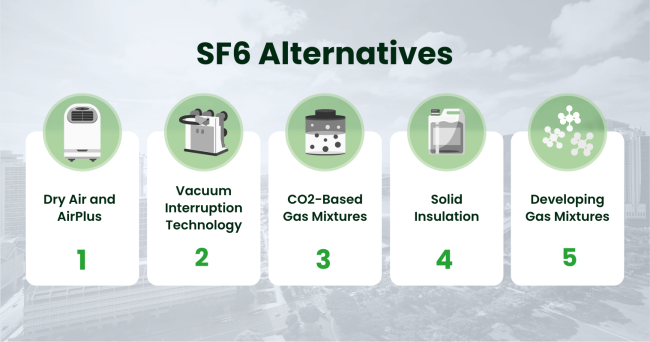
- Dry Air and AirPlus: Dry air and AirPlus (a gas mixture containing CO2 and fluoroketones) are gaining traction as eco-friendly substitutes for SF6 in medium-voltage switchgear. These alternatives significantly reduce environmental impact while maintaining performance.
- Vacuum Interruption Technology: Vacuum circuit breakers eliminate the need for SF6 by using a vacuum to extinguish electrical arcs. This technology is already widely used in medium-voltage applications.
CO2-Based Gas Mixtures: Some solutions involve combining CO2 with other gases to achieve the desired insulation properties. These mixtures have a lower GWP compared to SF6. - Solid Insulation: Solid-state insulation materials, such as epoxy resin, are increasingly used in switchgear and transformers. These materials eliminate the need for gas altogether, offering a sustainable solution.
- Developing Gas Mixtures: Ongoing research into new gas mixtures, such as those incorporating fluoronitriles or other non-greenhouse gases, continues to push the boundaries of SF6 alternatives.
What are the regulations and policies on the use of SF6?
Governments and international organisations have recognised the risks posed by SF6 and are working to regulate its use. Policies vary across regions, but key efforts include monitoring, reporting, and reducing SF6 emissions:
- Kyoto Protocol: SF6 was identified as one of six greenhouse gases targeted for reduction under the Kyoto Protocol. Countries committed to lowering SF6 emissions through improved monitoring and technical measures.
- EU F-Gas Regulation: The European Union has taken a leadership role in its F-Gas Regulation. This new regulation mandates the reduction of fluorinated gases, including SF6. It includes strict reporting requirements and calls for industries to minimise leakage and explore alternatives.
- US EPA Programs: In the United States, the Environmental Protection Agency (EPA) has initiatives to encourage industries to voluntarily reduce SF6 emissions. Programs such as the SF6 Emission Reduction Partnership for Electric Power Systems promote best practices for gas management.
- Southeast Asia:
- Singapore: While no dedicated SF₆ regulation exists yet, Singapore incorporates fluorinated gases into its broader sustainability strategies. Industries are encouraged to adopt technologies that minimise emissions, supporting the city-state’s climate targets and ESG commitments.
- Malaysia: Although SF₆-specific policies are absent, Malaysia participates in international climate agreements like the Kyoto Protocol. Improved transparency in greenhouse gas inventories indirectly aligns with ESG principles, particularly for energy-intensive sectors.
ESG Implications of SF₆ Management
As climate change takes centre stage in ESG frameworks, addressing high-impact greenhouse gases like SF₆ is no longer optional but a necessity for companies seeking to demonstrate environmental responsibility.
With its extreme global warming potential and long atmospheric lifespan, SF₆ represents a critical factor in environmental performance. Companies, that are within relevant industries like electrical power and manufacturing, are now expected to disclose detailed emissions data under ESG reporting standards like the Greenhouse Gas Protocol, Global Reporting Initiative (GRI), and Task Force on Climate-related Financial Disclosures (TCFD). Addressing SF₆ in these disclosures demonstrates a commitment to transparency and sustainability, boosting a company’s ESG profile.
Undoubtedly, businesses that take meaningful steps to reduce SF₆ emissions position themselves as responsible stewards in the fight against climate change while reinforcing their standing in an increasingly ESG-conscious market.
Simplify Greenhouse Gas Management and Reporting with Convene ESG

The first step in addressing SF₆ emissions is accurate measurement.
Convene ESG, one of the leading ESG reporting software, provides organisations with tools to benchmark their emissions against their sustainability goals and global standards. Through real-time data and actionable insights, companies can take control of their environmental impact and make informed decisions about transitioning to greener alternatives.
By adopting cutting-edge ESG software like Convene ESG, your business can stay ahead of regulatory changes, improve ESG reporting, and drive the shift toward a future of net-zero.
Begin your journey and book a demo today.
